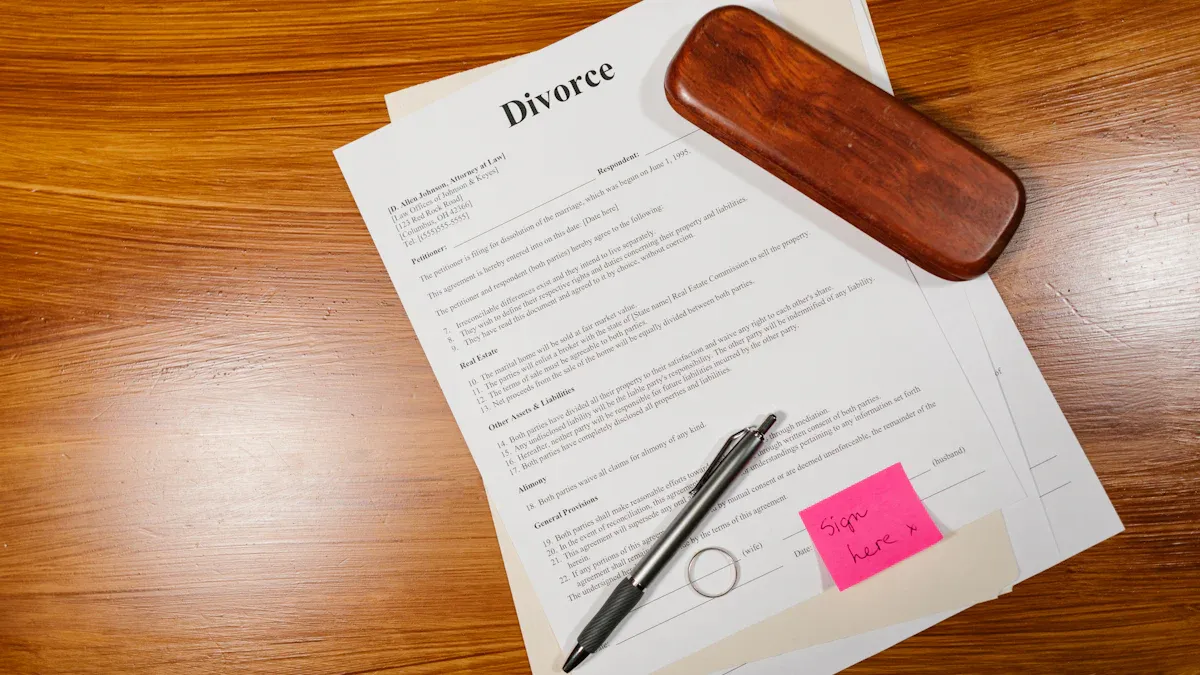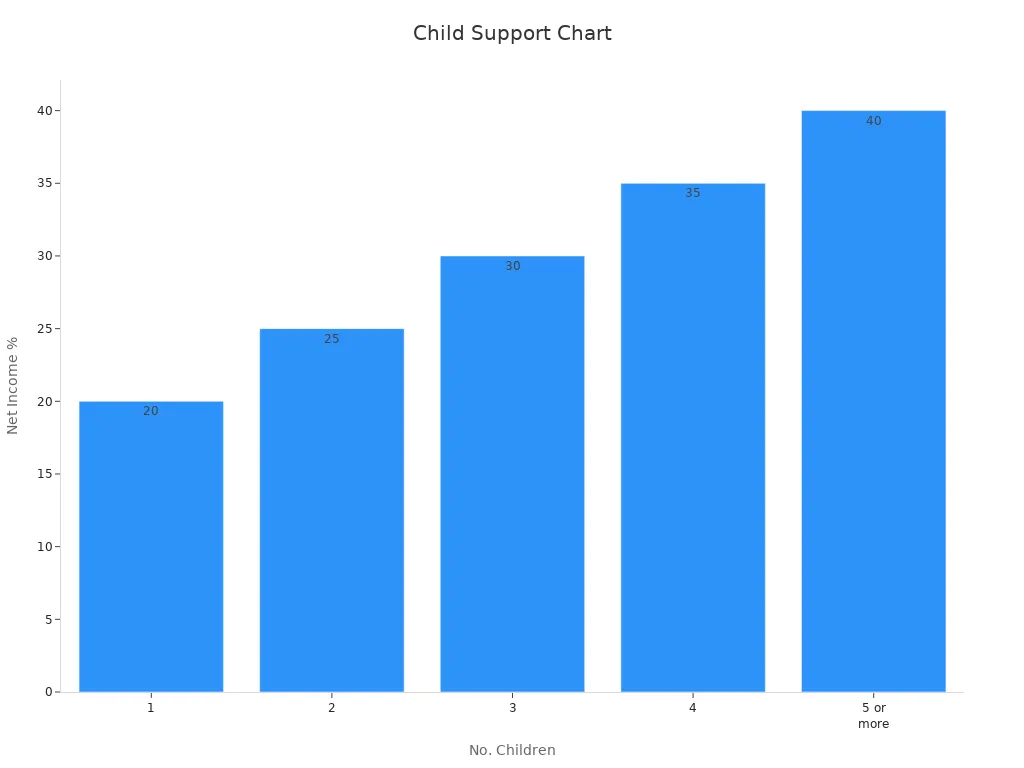How to File for Divorce in Texas in 2025

Filing for a Texas divorce might seem hard, but knowing the basics helps. One spouse must live in Texas for six months. They also need to reside in the county for 90 days. Divorce fees for a Texas divorce typically cost between $250 and $400, depending on the county. If you're filling out forms or filing an uncontested Texas divorce, take it step by step. This approach makes handling paperwork and legal rules easier.
Tip: Check residency rules before filing your Texas divorce to prevent delays.
Texas Divorce Basics

Residency Rules for Divorce in Texas
To file for divorce in Texas, you must meet certain rules. These rules let Texas courts handle your case. You or your spouse must live in Texas for six months. You also need to live in the county for 90 days before filing.
Requirement | Time Needed |
|---|---|
Live in Texas | |
Live in County | At least 90 days |
If you don’t meet these rules, you’ll have to wait. Following this step avoids delays in your Texas divorce process.
Tip: Always check residency rules first. Ask a divorce lawyer if you’re unsure about meeting them.
Reasons for Divorce Under Texas Laws
In Texas, you can file for divorce with or without blaming anyone. The most common no-fault reason is "insupportability." This means the marriage isn’t working because of problems that can’t be fixed. It’s easier since no one has to prove fault.
Fault-based reasons include:
Adultery: If your spouse cheated, it may affect property and support.
Cruelty: Abuse, whether physical or emotional, that makes living together impossible.
Abandonment: When a spouse leaves for at least one year without plans to return.
Felony Conviction: If your spouse is in prison for a felony for at least one year.
Pick the reason that fits your situation best. If unsure, talk to a divorce lawyer for advice.
Contested vs. Uncontested Divorce in Texas
When filing for divorce, decide if it’s contested or uncontested. An uncontested divorce happens when both spouses agree on everything. This includes property, child custody, and support. It’s quicker and costs less.
A contested divorce happens when spouses disagree on any issue. This makes the process longer and harder.
Term | Meaning |
|---|---|
Agreed Divorce | Both spouses agree on all terms and sign forms. |
Uncontested Divorce | No disagreements, making the process easier. |
Contested Divorce | Spouses argue over terms, needing court help. |
Property gained during marriage that belongs to both spouses. |
Knowing if your divorce is contested or not helps you plan better. If there are disagreements, a divorce lawyer can help make things easier.
Basic Steps to Start the Process
Getting Ready to File for Divorce in Texas
Before filing for divorce in Texas, being prepared is important. First, learn about Texas divorce laws. Understand rules about residency, reasons for divorce, and dividing property. This helps avoid unexpected problems. Then, collect your financial papers. Include bank records, tax forms, and lists of debts or assets. Staying organized makes things easier.
Talking to a lawyer is also a smart step. They can explain your rights and guide you. If you and your spouse agree, try mediation. It can solve problems without court, saving time and money.
Tip: Preparing early helps you feel more confident and ready.
Filing the Original Petition for Divorce
The first step in a Texas divorce is filing the Original Petition for Divorce. This paper starts the legal process. It must list key details like your name, your spouse’s name, when you married, and why you want a divorce. Follow Texas Family Code § 6.001 to avoid delays.
Filing first has some benefits. You pick the court and set the timeline. But, you must pay filing fees, usually $250 to $400, depending on the county. If the case becomes contested, filing first might increase legal costs.
Note: Check your petition carefully before giving it to the court.
Giving Divorce Papers to Your Spouse
After filing, you must give the divorce papers to your spouse. This step ensures they know about the case. In Texas, there are different ways to do this:
Method | Description |
|---|---|
Personal Service | A neutral person hands the papers directly to your spouse. |
Mail Service | Papers are sent by certified mail with proof of delivery. |
Substituted Service | If your spouse can’t be found, papers go to someone at their home who is 16 or older. |
Service by Posting | A notice is posted publicly if your spouse’s location is unknown. |
Service by Publication | A notice is printed in a newspaper if your spouse cannot be located. |
Personal service is the most common way. If your spouse is missing, you may need court approval for other methods like posting or publication.
Tip: Serving papers correctly is very important. Mistakes can slow down your case, so follow the rules.
Responding to the Divorce Petition
When you get divorce papers, act fast. In Texas, you have 20 days plus the next Monday to reply. This reply is called an "Answer." It tells the court if you agree or disagree with the claims. If you don’t respond, the court might give a default judgment to your spouse. This means they could get everything they asked for.
Here’s a simple timeline of what happens after being served:
Action | Timeframe | Outcome |
|---|---|---|
Reply to divorce papers | 20 days plus the next Monday | Avoid default judgment |
No reply | After 20 days | Court may favor your spouse |
Divorce finalized | After 60-day waiting period | Divorce decree or default judgment |
If you and your spouse agree on everything, you can file for an uncontested divorce. This saves time and money. But if you disagree, prepare for a contested divorce. This may involve court hearings and extra paperwork.
Tip: Always reply to divorce papers. Even if you want an uncontested divorce, replying protects your rights.
Temporary Orders and Waiting Periods
Life doesn’t pause during a divorce. You still need to handle bills, child care, and housing. Temporary orders help manage these things while the divorce is ongoing. They decide who pays bills, who stays in the house, and how kids’ time is split.
Temporary orders last until the court gives a final divorce decree. Their length depends on your case:
Duration Scenario | Description |
|---|---|
Until Court Changes It | Orders stay until the court makes a new decision. |
Until Both Agree | Orders can change if both sides agree and tell the court. |
Until Final Order | Orders last until the final divorce or custody decision is made. |
Case Complexity | Orders can last months or over a year, depending on the case. |
In Texas, there’s also a 60-day waiting period before the divorce is final. This time lets both sides think and possibly agree. If you want an uncontested divorce, use this time to finish your paperwork.
Note: Temporary orders keep things steady during a divorce. Know how they affect you and your family.
Costs and Financial Considerations in a Texas Divorce
Filing Fees and Court Costs
Divorcing in Texas costs money upfront. Filing fees range from $100 to $400, depending on your county and case details. Extra services, like hiring a process server or getting certified copies of your divorce papers, cost more. On average, divorces without lawyers cost about $925, with a typical cost of $300.
Here’s a simple cost breakdown:
Filing fees: $100–$400
Process server fees: Depends on location
Certified document copies: Extra charges
To save money, you can handle an uncontested divorce yourself. But make sure you understand the forms and legal steps.
Tip: Ask your local courthouse about filing fees and extra costs early.
Attorney Fees and Legal Representation
Lawyer fees are often the biggest divorce expense. In Texas, costs depend on your case’s difficulty and whether it’s contested or not. For uncontested divorces, lawyer fees range from $300 to $5,000. Contested divorces, with disagreements over property or custody, cost $5,000 to over $20,000.
Mediation is a cheaper option if you want to save money. It costs about $3,000 to $8,000 and helps settle problems faster, saving time and stress.
Note: A lawyer protects your rights. If your case is tricky, hiring one can help a lot.
Property Division Under Texas Divorce Laws
Texas uses community property laws, meaning most things earned or owed during marriage are split equally. But dividing property can be hard. Things like houses, retirement accounts, and other assets make it tricky. For example, the National Association of Realtors said the average home price in 2021 was $353,600, showing how big real estate can be in divorce deals.
Keeping good financial records is important. In 2017, the U.S. Census Bureau found only 62.6% of child support payments were received nationwide. This shows why clear agreements and proper paperwork matter in divorce.
Tip: Collect financial papers early. Include bank statements, tax returns, and property deeds. Being ready helps avoid problems later.
Alimony and Spousal Support in Texas
Alimony, also called spousal support, is important in Texas divorces. If you think you might pay or receive it, learning the basics helps.
What Is Alimony in Texas?
Alimony is money one spouse gives the other after divorce. It helps the receiving spouse pay for living costs after marriage ends. In Texas, alimony isn’t automatic. You must meet certain rules to qualify.
Who Can Get Alimony?
To get alimony, you must prove you can’t cover basic needs alone. Texas courts look at things like:
How long you were married (usually 10 years or more).
If you can earn enough money.
If you cared for kids or helped your spouse’s career.
Any domestic violence in the last two years.
Tip: Unsure if you qualify? Ask a divorce lawyer. They can explain Texas laws for your case.
How Much and How Long?
The amount and time for alimony depend on your situation. Texas law limits alimony to $5,000 monthly or 20% of the paying spouse’s income, whichever is lower. Payment length depends on marriage duration:
10–20 years: Up to 5 years of payments.
20–30 years: Up to 7 years of payments.
30+ years: Up to 10 years of payments.
Can Alimony Change?
Yes, but only in certain cases. If the receiving spouse remarries or the paying spouse’s finances change a lot, the court might adjust or stop payments.
Note: Alimony isn’t promised in Texas. Strong proof can help your case.
Child Custody and Support in Texas

Deciding Child Custody in Texas
In Texas, courts decide child custody based on the child’s best interest. They look at many things to figure out custody and parenting time. Here are some key points judges consider:
Factor | What It Means |
|---|---|
Parental Involvement | How much each parent has been part of the child’s life. |
Living Conditions | If the home is safe, stable, and good for the child. |
Parenting Abilities | If the parent can meet the child’s emotional and physical needs. |
Child’s Preference | The child’s opinion, if they are old enough to share it. |
Judges also think about the child’s age, health, and emotional needs. For example:
Criteria | What It Means |
|---|---|
Child’s age and health | If the child’s needs match what the parent can provide. |
Parent’s age and health | If the parent is healthy enough to care for the child. |
Home environment | If the parent’s home is a good place for the child to live. |
History of abuse or substance issues | If there are past problems that could affect parenting. |
If you’re worried about custody, show you can give a stable, loving home. Courts like parents who stay involved in their child’s life and meet their needs.
Tip: Keep proof of your involvement, like attending school events or doctor visits. This can help your case.
Figuring Out Child Support in Texas
Texas uses a simple formula to set child support. It depends on how many kids you have and the paying parent’s net income. Here’s the breakdown:
Number of Children | Percent of Net Income |
|---|---|
1 | 20% |
2 | 25% |
3 | 30% |
4 | 35% |
5 or more | 40% |
For example, if you have two kids and earn $4,000 a month, you’d pay 25%. That’s $1,000 each month to support your children.

Note: Bonuses or overtime don’t count unless they happen often. Understand what counts as net income before calculating.
Changing Custody or Support Agreements
Sometimes, life changes mean custody or support agreements need updates. Texas courts allow changes if certain rules are met. Here’s what to know:
You need proof of a big life change, like moving, remarriage, or a new lifestyle.
For child support, income must change by $100 or 20%, and it must be at least three years since the last order.
The court will hold a hearing where both parents share evidence. The judge will decide after reviewing everything.
Tip: Keep records of big life changes. These can help you when asking for a modification.
Filing for divorce in Texas in 2025 doesn’t have to feel overwhelming. By understanding the legal steps and preparing ahead, you can make the process smoother. Gather your documents, know your rights, and take it one step at a time. If things get tricky, don’t hesitate to reach out to a professional for guidance.
Tip: Staying informed and organized can save you time, money, and stress. You’ve got this! 😊
FAQ
What happens if my spouse ignores the divorce papers?
If your spouse doesn’t reply in 20 days plus the next Monday, the court might decide without them. This is called a default judgment, where the judge approves the divorce based on your requests. Make sure the papers are served correctly to avoid problems.
Tip: Save proof that your spouse got the papers. It helps your case.
Can I get divorced in Texas without hiring a lawyer?
Yes, you can handle it yourself, especially for simple, uncontested divorces. But you must understand the forms and steps. Mistakes could cause delays or bad results. For tricky cases, getting a lawyer is a good idea.
Note: Some counties provide free help for people representing themselves.
How long does it take to get divorced in Texas?
The shortest time is 60 days because of the waiting rule. If there are disagreements about property or kids, it could take months or even years, depending on how complicated it is.
Can I change my name during the divorce?
Yes, you can ask for a name change in your divorce papers. The court will include it in the final divorce order. Many people do this to go back to their maiden name.
Tip: After the divorce, update your name on important documents.
Do I need to go to court for an uncontested divorce?
Not always. For many uncontested divorces, you can finish everything without going to court. Some counties let you send forms online or by mail. Check your local court’s rules to be sure.
Note: Even for simple divorces, double-check all forms for accuracy.
See Also
Starting Fresh in Texas After Your 2025 Divorce
Initiating Your Divorce Journey in Texas: A Guide
Navigating the Divorce Process in Texas Successfully
Subscribe to get the updates!
Sign up now to receive timely blog updates.
I accept the email subscription terms.

